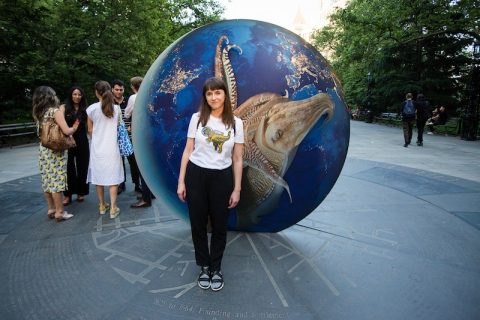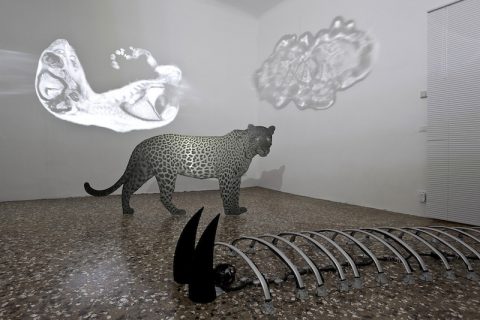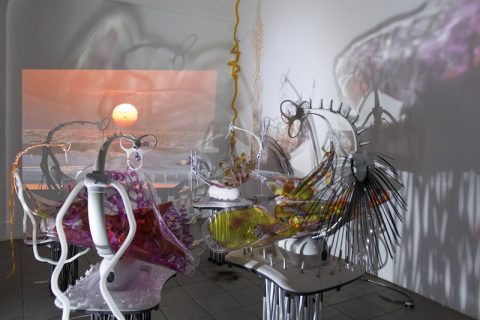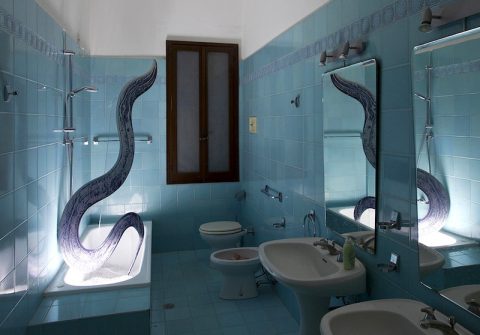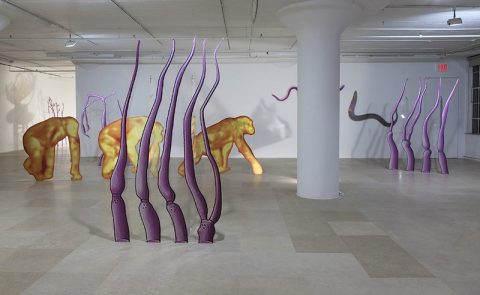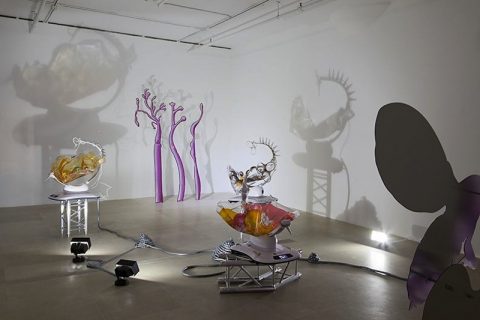Katja Novitskova: a comprehensive interview
A solo exhibition at Green Naftali, NY Public Art Fund’s commission and the Venice Biennale won Katja Novitskova the status of rising art star. CFA sat down with the arstist to take stock of her work’s poetics.
- Portrait of Katja Novitskova with Earth Potential (Cuttlefish Love, Earth), 2017 in City Hall Park, New York. Photo: Liz Ligon
- Katja Novitskova, Earth Potential (C. elegans Saturn’s Moon Titan), 2017 in City Hall Park, New York. Courtesy the artist, Kraupa-Tuskany Zeidler, Berlin; and Greene Naftali, New York. Photo: Jason Wyche, Courtesy Public Art Fund, NY
- Katja Novitskova, Earth Potential (E. coli), 2017 in City Hall Park, New York. Courtesy the artist, Kraupa-Tuskany Zeidler, Berlin; and Greene Naftali, New York. Photo: Jason Wyche, Courtesy Public Art Fund, NY
- Katja Novitskova: If Only You Could See What I’ve Seen with Your Eyes at the 57th Venice Biennale, Estonian Pavilion, Venice. Courtesy the artist, Kraupa-Tuskany Zeidler, Berlin and Greene Naftali, New York. Photo: Holger Niehaus.
- Katja Novitskova: If Only You Could See What I’ve Seen with Your Eyes at the 57th Venice Biennale, Estonian Pavilion, Venice. Courtesy the artist, Kraupa-Tuskany Zeidler, Berlin and Greene Naftali, New York. Photo: Holger Niehaus.
- Katja Novitskova: If Only You Could See What I’ve Seen with Your Eyes at the 57th Venice Biennale, Estonian Pavilion, Venice. Courtesy the artist, Kraupa-Tuskany Zeidler, Berlin and Greene Naftali, New York. Photo: Holger Niehaus.
- Katja Novitskova, Approximation (Storm Time) at Greene Naftali, 18 November 2016 – 7 January 2017. Courtesy the artist and Greene Naftali, New York
- Katja Novitskova, Approximation (Storm Time) at Greene Naftali, 18 November 2016 – 7 January 2017. Courtesy the artist and Greene Naftali, New York.
A rising international art star that mines the Internet for source material, Katja Novitskova has a knack for turning scientific information and everyday consumer products into thought-provoking art. Representing her native Estonia in this year’s Venice Biennale, Novitskova made her first big splash in the New York art world in MoMA’s “Ocean of Images: New Photography” exhibition in 2015 and is back in the city with a solo Public Art Fund project at City Hall Park. Conceptual Fine Arts sat down with the artist when she was in New York to discuss her ingenious mingling of ecology, astronomy and jpegs in her photo-sculptures and the robotic machines she curiously altered for her recent exhibition at Greene Naftali and for her current installation in Venice.
How does the title of your Public Art Fund exhibition “Potential Earth” frame and introduce your work in City Hall Park?
The works that I have been making for the past five years follow similar principles or patterns. I have three types of titles for them and one of them has a relationship to potentiality—a growth potential or the potential of a new frontier in different forms, such as a frontier in space or a frontier in a biological or social process. The other sets of titles are “patterns of activation,” which relate to installations and pattern processing, and “approximations,” that are also about patterns but more about vision, while coming from the idea that a frog is more complex than an iPhone.. For this body of work, which falls into the category of the potentials, I decided to treat the City Hall Park as an alien landing site, where outsiders could look at the Earth as a new frontier, and the potential for within the Earth as to how we see it and what is happening to it, which relates to both social and ecological dimensions. Katja Novitskova
When did you develop your interest in science and why did you decide to make it one of the focal points for your art?
I have an interest in new forms of visual culture. I grew up in a very gray, social housing, post-Soviet neighborhood and reading books about the planets, dinosaurs and ancient Egypt was my form of escape. I intuitively identify the contemporary with science, including astronomy, biotechnology and medical research, because they produce new forms of visual representation without an aesthetic purpose yet at a massive volume and rate. For me, it’s a logical place to look for new forms of representation that are reflecting the concentric condition of the world.
What role do non-human animals play in your work?
When we talk about representation of the world the most crucial point that needs to be made today is that it is not just bound to our species. There are forms of vision of the world and forms of engagement with it that are parallel to our lives but are done by other creatures. In order to have a more harmonious relationship with the world—with the different ecologies and the emergence of machine consciousness and vision—it’s obligatory to gain empathy and understanding of how other creatures engage with the world and include them in one way or another, rather than just conquering them. Katja Novitskova
And technology? What role does it play?
There are different types of technology. What interests me is the technology at the frontier of expanding human involvement with the world that always includes mapping. Any form of colonization, whether it’s the violent or non-violent, involves the process of mapping and discovery from the point of pioneers. That form of technology includes cameras, satellites, microscopes, space probes and image processing algorithms that turn data into pictures. This all interests me because it’s an expansion of what we know about the world and it’s an expansion in an individual sense because if you are mapping something it’s still a form of colonization. The tension is also interesting because there are ethical issues related to new scientific frontiers. Katja Novitskova
What draws you to a kind of yin-yang, macro-micro point of view?
My engagement with this imagery doesn’t happen in a laboratory; it happens on the Internet, where everything exists as a jpeg. It doesn’t matter if it’s an image of a planet or the image of an earthworm. It’s just a file form that’s on the screen and it all looks the same size. It’s one of the main artistic tricks in sci-fi horror films, where all of a sudden a sandworm becomes a dune monster. Katja Novitskova
What led you to mine the Internet for your source material?
I went to art school as a kid, where I made drawings and paintings. When I applied to the art academy in Estonia I didn’t get into the art program, but I got into semiotic and culture studies. I was still interested an applied visual practice and thought that I might become a graphic designer. When I was later moving from dorm to dorm at schools in Germany and The Netherlands I only had my computer. I started playing with Photoshop and CorelDraw and other software programs to make visual things and design websites. When I began making art I just made files and found different ways to print them out. It was the cheapest way to do it—and since I didn’t have any money, it was the only way. Katja Novitskova
What type of data attracts your mind and eye?
It’s always changing. I have folders of images labeled by years. They’re digital folders of images that I’ve downloaded online or captured with screenshots. I look through them and make connections and then something happens. It may be by accident, such as downloading an image of a hydra in the deep seas and then looking for all kind of images of hydras. As soon as I get an idea that I find interesting I start Googling and grabbing images. The focus changes from year to year. For example, in 2012 there were a lot of animals interacting with each other and with technology, while last year I was fascinated with medical research imagery and the year before it was astronomical images. It’s all based on intuition, but intuition can be seen as a form of filtering and pattern processing. I’m almost like a weird filter—or vacuum cleaner of images.
How do you decide on the format for the presentation of your work?
It’s actually the first time that the art world enters my thoughts. For example, when I initially made the kind of cutout pieces that I’m showing in the park I considered the most reduced way to make a sculpture. I came up with the idea of making the type of cutout display that you see in a mall or a cinema. It’s a sculptural statement, but it’s the simplest thing you can do. I want it to be Instagrammable. Katja Novitskova
The next layer came with working with resins, where the material can bring the digital images to life, but the material is so weird that it keeps this virtuality. It looks like a 3D rendering, although it’s a real object. The combination of digital print and resin makes a sculptural object that blurs the boundary between these two realms. I like the way the amber of the resin relates to fossilization. My interests in working with digital images comes from my book Post Internet Survival Guide, where there is this idea of time-capsuling digital data in the form of an image and making a fossil out of it.
The next stage of production was introducing the machines—the baby swings. I was already getting this visual intensity that triggers people, but it was very static so I decided that I wanted to do something that was the opposite—without a photographic image—but that also triggered the spectator as soon as he walked into the room. I thought some robotic dinosaur shape is what it should be—something animalistic and simple. When I saw the baby swing I thought this is it. And then I started to combine all of these elements and add video projection, as I’ve done in Venice. Katja Novitskova
What’s your attraction to assemblage and collage?
I think it’s a lack of skill. No, but I’m really impatient so I like the immediate triggers—I enjoy the immediacy of making something happen, like a digital collage. I’m not making a sculpture, but I’m making an image that could become a sculpture. I immediately get a satisfaction or non-satisfaction with it. I don’t need to wait a month after working in the studio for it. That’s what makes it fun or, at least, makes it alive for me. I like to make sculptures in my bed or on the train and this is just an easy way to do it. Katja Novitskova
Do you consider yourself to be a Net Artist?
I think I’m a Net-Art-inspired-artist. Technically, I was probably a few years too late to be part of that scene, but I was definitely inspired by a lot of people from the Net Art community.
What do you hope to happen when you bring an image out of the computer and into the real world?
The Internet is an ocean of images. It’s hard to give attention to specific things on the Internet because it’s overwhelming. I don’t want to flood the gallery space with this ocean; I want to choose very specific signals and filter a specific thing and blow it up and activate it in the space so that only then will it get the focus that it really needs. There’s something about the simplicity of a background with an image in the foreground that has a very specific visual set-up, which you find in 3D software, for example. There’s a strategic space with an object in the middle and I see a similar relationship with a gallery space. In the park it can be seen as part of this software space, where the park is a texture and the sculpture is just an object that’s well rendered. There’s something about the logic of digital image production, where it always has a horizon or abstract ground with something standing and nothing around it. It’s very isolated, which is a condition of contemporary image production. I find it interesting to replicate that condition in the gallery space. In the beginning I would just place one sculpture in the middle of an empty room to create that effect.
Are you acting like a filter? What does that word mean to you?
I know this is how I work, and filter is the best word that I’ve found to describe it.
I have thousands of images in a digital folder on my computer and I’m just browsing through them to find some signal. I’m looking at them almost too quickly to have any rational thoughts about what I’m seeing. When I find a form that I think will work it feels like being a filter, but I don’t know the settings of the filter. I browse pages and pages of images in Google Image search or any image database or on my own laptop. Once I have an arrangement I filter it even further. To realize the seven sculptures in the park there were many more versions of them. It’s just different degrees of filtering and cooking. Cooking and filtering are the metaphors that I’ve been using lately. It’s not really rational and it’s not really formalistic. It takes time. I cannot do everything in one day. It has to cook or stew in my head or the computer and then the next day I come back to it. I like to sleep on it and then look at it with a fresh eye.
Let’s talk about your modified baby swings, which you exhibited in your solo show at Greene Naftali last winter and are currently presenting as part of your Venice Biennale show in the Estonian Pavilion. How did you stumble upon these devices and why do you think your transformation of them is so appealing?
I was looking for a machine-like, robotic form that would have some level of intensity. I considered looking into some Japanese robots, but they didn’t feel right—they were too literal, too obvious. I was thinking of something closer to the dinosaurs in Jurassic Park. Because I don’t have a television, I watch a lot of YouTube. I had been watching a lot of family-bloggers and mom-bloggers documenting their pregnancies. I found it interesting as a kind of frontier, where people create a video about their lives and the materialism involved. It was all about going to the mall and getting products, so the videos were like the ten best products during pregnancy or the ten best products after labor—listicle-like videos that share what helps and what doesn’t. One of the things that I saw was this baby swing and I ordered one immediately. I ordered several different versions, with some of them looking like birds. When I got them to the studio I stripped them of all of the baby elements—the toys and the plush seats—so that just the skeletons remained. They are simple machines that just move in different directions, but visually they look half-animal, half-robot—like something that was designed for the military-industrial complex rather than for babies.
I thought about how should I respond to it and it felt like I should just decorate them in a symmetrical, ornamental way—maybe like a bowerbird would decorate its nest with a kind of folk symmetry. I was inspired by Isa Genzken’s sculptures and thought that I should just use cheap materials, like Plexiglas. While Genzken does it in a very expressive, non-symmetrical way I decided to follow the symmetry of the machines. Once you have a group of them, relationships form between them, which I amplified by adding laser-beam eyes. They scan the world, which relates to the rovers on Mars or the robots that go to the deep seas. I have this fantasy of them being at the edge of frontiers, where they are a little bit wild—and it works. You don’t need the most complex thing; you just need something simple. It somehow activates that state of mind. Katja Novitskova
Is this merger of matter and information the heartbeat of a new aesthetic frontier?
There is something dark about the idea of a new frontier. When I’m engaging these things I’m not blind to the language, which comes from colonial history. At the same time it is exciting because it is a way of seeing the world unlike a way we’ve ever seen it before. There is a relationship between the military-industrial complex and the design of a baby swing. I have the impulse to register these relationships. It’s both scary and exciting.
You haven’t asked about it, but at some point I decided not to use images of people at all in the work. That was because it immediately introduces the social layer and the social layer is actually the most important layer. A lot of artists are already dealing with this social layer in profound ways, so I decided that I’m not going to work with it directly. Of course, the idea of the human being is present in all of the work and how you respond to it is based on your position in the world—whose eyes are you looking through? This non-human, mechanical aspect of the frontier is what I’m looking at but it’s not at the expense of the human. I’m just adding this perspective that we don’t see that much and I feel like maybe that’s my role. There are things that constantly need to be questioned. I’m just doing it in my own way. I’m channeling all of these things. It comes from animals interacting with animals, people interacting with animals, machines interacting with animals and machines interacting with people. There are all of these new gradients emerging and it’s not really clear what’s happening. I’m just trying to process a very small part of it as my work.
September 29, 2017

